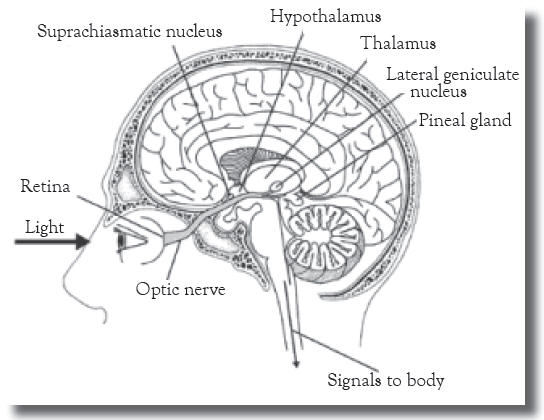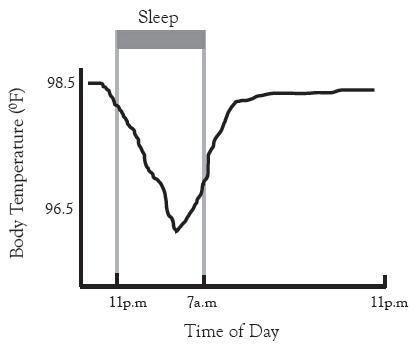Lesson 1: Clinical Disorders – Part D
PART D
Biological Clocks
An internal biological clock regulates the timing for sleep in humans. The activity of this clock makes us sleepy at night and awake during the day. Our clock cycles with an approximately 24-hour period and is called a circadian clock. In humans, this clock is located in the suprachiasmatic nucleus (SCN) of the hypothalamus in the brain (see Figure 6.1). The SCN is actually a very small structure consisting of a pair of pinhead-size regions, each containing only about 10,000 neurons of the brain’s estimated 100 billion neurons.
Figure 6.1
The biological clock is located within the suprachiasmatic nucleus in the brain.
Biological clocks are genetically-programmed physiological systems that allow organisms to live in harmony with natural rhythms, such as day/night cycles and the changing of seasons. The most important function of a biological clock is to regulate overt biological rhythms such as the sleep/wake cycle. The biological clock is also involved in controlling seasonal reproductive cycles in some animals through its ability to track information about the changing lengths of daylight and darkness during a year.
Biological rhythms are of two general types. Exogenous rhythms are directly produced by an external influence, such as an environmental cue. They are not generated internally by the organism itself, and if the environmental cues are removed, the rhythm ceases. Endogenous rhythms, by contrast, are driven by an internal, self-sustaining biological clock rather than by anything external to the organism. Biological rhythms, such as oscillations in core body temperature, are endogenous. They are maintained even if environmental cues are removed.
Because the circadian clock in most humans has a natural day length of just over 24 hours, the clock must be entrained, or reset, to match the day length of the environmental photoperiod (that is, the light/dark, or day/night, cycle). The cue that synchronizes the internal biological clock to the environmental cycle is light. Photoreceptors in the retina transmit light-dependent signals to the SCN. Interestingly, our usual visual system receptors, the rods and cones, are apparently not required for this photoreception. Special types of retinal ganglion cells are photoreceptive, project directly to the SCN, and appear to have all the properties required to provide the light signals for synchronizing the biological clock. At the SCN, the signal interacts with several genes that serve as “pacemakers.”
Figure 6.2:
Body temperature in relation to the sleep cycle

Another interesting rhythm that is controlled by the biological clock is the cycle of body temperature, which is lowest in the biological night and rises in the biological daytime. This fluctuation persists even in the absence of sleep. Activity during the day and sleep during the night reinforce this cycle of changes in body temperature, as seen in Figure 6.2.
The release of melatonin, a hormone produced by the pineal gland, is controlled by the circadian clock in the SCN. Its levels rise during the night and decline at dawn in both nocturnal and diurnal species. (Nocturnal animals are more active at night and diurnal animals are more active during the day). Melatonin has been called the hormone of darkness because of this pattern. The SCN controls the timing of melatonin release; melatonin then feeds back on the SCN to regulate its activity. In mammals, for example, most of the brain receptors for melatonin are located in the SCN. Research has demonstrated that administering melatonin can produce shifts in circadian rhythms in a number of species including rats, sheep, lizards, birds, and humans. These effects are most clearly evident when melatonin is given in the absence of light input. For example, giving melatonin to blind people can help set their biological clocks. Melatonin is available as an over-the-counter nutritional supplement. Although claims are made that the supplement promotes sleep, the evidence for this is inconclusive. Potential side effects of long-term administration of melatonin remain unknown, and its unsupervised use by the general public is discouraged.
In addition to synchronizing these daily rhythms, biological clocks can affect rhythms that are longer than 24 hours, especially seasonal rhythms. Some vertebrates have reproductive systems that are sensitive to day length. These animals can sense changes in day length by the amount of melatonin secreted. The short days and long nights of winter turn off the reproductive systems of hamsters while in sheep the opposite occurs. The high levels of melatonin that inhibit reproduction in hamsters stimulate the reproductive systems of sheep, so they breed in winter and give birth in the spring.
One negative consequence of our circadian cycle afflicts travellers who rapidly cross multiple time zones. Jet lag produces a number of unwanted effects including excessive sleepiness, poor sleep, loss of concentration, poor motor control, slowed reflexes, nausea, and irritability. Jet lag results from the inability of our circadian clock to make an immediate adjustment to the changes in light cues that an individual experiences when rapidly crossing time zones. After such travel, the body is in conflict. The biological clock carries the rhythm entrained by the original time zone although the clock is out of step with the cues in the new time zone. This conflict between external and internal clocks and signals is called desynchronization, and it affects more than just the sleep/wake cycle. All the rhythms are out of sync, and they take a number of days to re-entrain to the new time zone.
Eastward travel generally causes more severe jet lag than westward travel, because traveling east requires that we shorten our day and adjust to time cues occurring earlier than our clock is used to.
In general, the human circadian clock appears better able to adjust to a longer day than a shorter day. For example, it is easier for most people to adjust to the end of daylight savings time in the fall when we have one 25-hour day than to the start of daylight savings time in the spring, when we have a 23-hour day. Similarly, traveling from the West Coast to the East Coast produces a loss of three hours—a 21-hour day. Thus, travellers may find sleeping difficult because of the three-hour difference between external cues and their internal clocks. Likewise, travelers may find awakening difficult in the morning. We may try to go to sleep and wake up at our usual local times of, say, 11 p.m. and 7 a.m., but to our brain’s biological clock, the times are 8 p.m. and 4 a.m
Other circadian rhythm problems include the following:
|
1. Monday morning blues. By staying up and sleeping an hour or more later than usual on the weekends, we provide our biological clock different cues that push it toward a later nighttime phase. By keeping a late sleep schedule both weekend nights, our internal clock becomes two hours or more behind our usual weekday schedule. When the alarm rings at 6:30 a.m. on Monday, our body’s internal clock is now set for 4:30 a.m. or earlier. 2. Seasonal affective disorder (SAD). A change of seasons in autumn brings on both a loss of daylight savings time (fall back one hour) and a shortening of the daytime. As winter progresses, the day length becomes even shorter. During this season of short days and long nights, some individuals develop symptoms similar to jet lag but more severe. These symptoms include decreased appetite, loss of concentration and focus, lack of energy, feelings of depression and despair, and excessive sleepiness. Too little bright light reaching the biological clock in the SCN appears to bring on this recognized form of depression in susceptible individuals. Consequently, treatment often involves using light therapy. 3. Shift work. Unlike some animals, humans are active during daylight hours. This pattern is called diurnal activity. Animals that are awake and active at night (for example, hamsters) have what is known as nocturnal activity. For humans and other diurnally active animals, light signals the time to awake, and sleep occurs during the dark. Modern society, however, requires that services and businesses be available 24 hours a day, so some individuals must work the night shift. These individuals no longer have synchrony between their internal clocks and signals of external daylight and darkness. They may experience mental and physical difficulties similar to jet lag and SAD. |